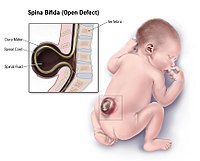
Photo from wikipedia
In 1891, Hans Chiari described a group of congenital hindbrain anomalies, which were eventually named after him. He classified these malformations into three types (Chiari malformations I, II and III),… Click to show full abstract
In 1891, Hans Chiari described a group of congenital hindbrain anomalies, which were eventually named after him. He classified these malformations into three types (Chiari malformations I, II and III), and 4 years later added the Chiari IV malformation. Nevertheless, researchers have been encouraged to propose new classifications to encompass some variants not fitting Chiari’s original descriptions (e.g. Chiari 0, Chiari 1.5 and Chiari 3.5 malformations). Each has distinct anatomical characteristics and some of these are extremely rare and incompatible with life (e.g. Chiari 3.5). Some physicians might be unfamiliar with the newer classifications of Chiari malformations because these conditions are rare or even unique. In fact, Chiari IV malformation has been further clarified. Furthermore, care is needed in using the term “Chiari IV malformation”, which must be consistent with Chiari’s original description, i.e. an occipital encephalocele containing supratentorial contents [2]. Arnold Chiari malformation type I (ACM) is a common and often debilitating neurological disease. Efforts to improve treatment of ACM are often impeded by inconsistent and limited methods of evaluating clinical outcomes. To understand current approaches and lay a foundation for future research, some authors have conducted a review of the methods used in original published research articles concluding that, in many clinical studies examined, the outcomes in patients treated for ACM are evaluated according to methods inconsistent and frequently not comparable. From the complications of the efforts to analyse results across studies, the need of validation become proactive to a new deal of more reliable follow-up determination [5]. As a matter of fact, in a neurosurgical population, similarly to hydrocephalus, ACM appears to significantly interfere with behavioural aspects and the Quality-of-life (QoL). Over the last decade, there has been growing evidence that neuropsychological deficits, principally in the executive functions, may be involved in the pathogenesis of ACM. Some studies have been conceived in order to compare changes in cognitive functions in patients with ACM and healthy subjects. From a pure methodological point of view, the neuropsychological profile of these patients has been compared with healthy controls and neuropsychological tests has been administered to both ACM patients and healthy controls in order to assess the frontal executive functions of vigilance or selective attention, mental flexibility, planning, and concept formation. The results obtained has suggested that ACM patients are affected in the processes of inhibition and self-control as well as in attention capacity and maintaining a course of thought and action so providing evidence of possible deficits or anomalies in the cognitive executive functions of these patients [3]. In other publications, patients with ACM have been examined on a large battery of neuropsychological tests, including executive functioning, verbal fluency, spatial cognition, language, verbal memory, processing speed, facial recognition and theory of mind. Results have shown a poorer performance of the clinical group compared with the control group, even after controlling the effect of physical pain and anxiousdepressive symptomatology. The findings have suggested the presence of a generalised cognitive deficit associated, which makes it necessary to focus attention not only on physical consequences but also on cognitive ones [4]. So QoL changes coexistence, along with the identification of its measurement instruments in ACM management, has become necessary to better understand the severity of the impact on patients’ lives. Among them, the Chiari Symptom Profile (CSP) is a valid and reliable instrument designed for this purpose [7]. This article is part of the Topical Collection on Neurosurgery general
Journal Title: Acta Neurochirurgica
Year Published: 2019
Link to full text (if available)
Share on Social Media: Sign Up to like & get
recommendations!